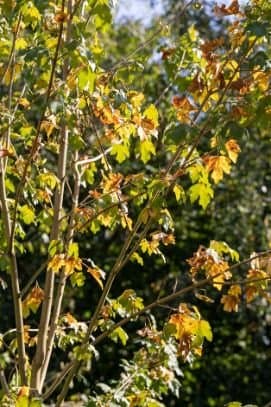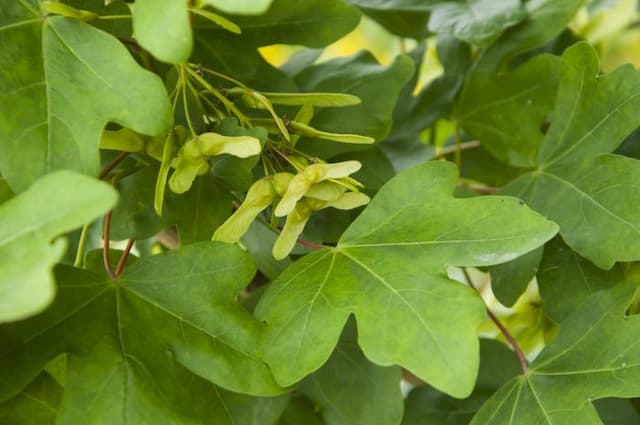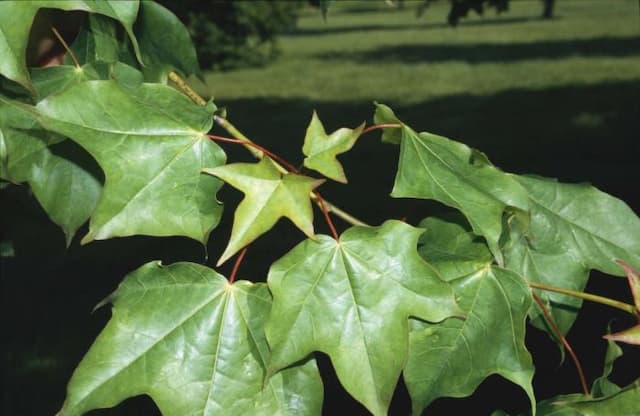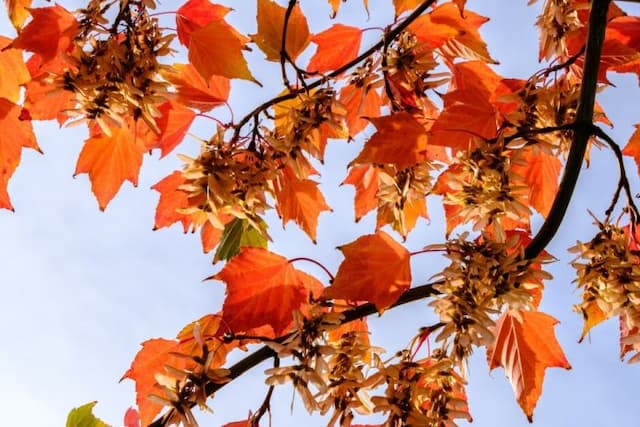Japanese Maple Acer palmatum 'Tsuma-gaki' (A)
ABOUT
The Japanese maple known as 'Tsuma-gaki' is celebrated for its unique and striking foliage. The leaves of this cultivar are deeply lobed and resemble the palm of a hand, with slender, finger-like projections that provide a delicate and graceful appearance. The name 'Tsuma-gaki' itself refers to the distinctively colored leaf tips, which are said to resemble painted fingernails. In spring, the leaves emerge with a vivid display of color, often a soft green with distinctively contrasting red or pink edging that creates a striking visual impact. As the seasons progress, the leaves undergo a transformation, with the green deepening, and the edging may fade or shift in hue, offering a dynamic show of color throughout the growing season. In autumn, the Japanese maple becomes a showcase of fiery colors, often displaying a range of yellows, oranges, and reds that make it a standout in any garden setting. The bark of the 'Tsuma-gaki' is typically smooth and adds an extra layer of interest, particularly during the winter months when the leaves have fallen, and the attractive structure of the branches is more visible. The overall shape of the plant is often balanced and rounded, contributing to its ornamental appeal. This Japanese maple is appreciated not only for its aesthetic qualities but also for the serene and elegant atmosphere it lends to gardens and landscape designs.
About this plant
 Names
NamesFamily
Sapindaceae
Synonyms
Japanese Maple, Tsuma-gaki Maple
Common names
Acer palmatum 'Tsuma-gaki'.
 Toxicity
ToxicityTo humans
Japanese maple is not considered toxic to humans. Generally, ingestion of parts of this plant does not lead to poisoning or serious side effects. However, individual allergies or sensitivities may exist. If such a sensitivity is present, ingesting parts of the plant might cause mild stomach upset or an allergic reaction. If any symptoms develop after ingesting any part of the plant, it is advisable to consult a doctor.
To pets
Japanese maple is also not considered toxic to pets. It's not commonly known to cause poisoning in pets such as dogs and cats if they ingest parts of it. However, similarly to humans, individual animals might have specific sensitivities that could lead to mild gastrointestinal upset. If a pet exhibits unusual symptoms after consuming any part of the plant, contacting a veterinarian would be prudent.
 Characteristics
CharacteristicsLife cycle
Perennials
Foliage type
Deciduous
Color of leaves
Varied
Height
6-8 feet (1.8-2.4 meters)
Spread
6-8 feet (1.8-2.4 meters)
Plant type
Tree
Hardiness zones
5-8
Native area
Japan
Benefits
 General Benefits
General Benefits- Aesthetic Appeal: Japanese Maple 'Tsuma-gaki' offers a unique ornamental look with its delicate leaves and lovely color changes, making it a focal point in any garden.
- Seasonal Interest: This variety provides excellent seasonal interest with its spring and autumn foliage colors, and interesting leaf shapes.
- Shade Production: The canopy of the Japanese Maple can offer a pleasant shade for underplantings or a cool spot in the garden during hot days.
- Wildlife Habitat: It can serve as a habitat for various species of birds and insects, supporting biodiversity.
- Small Size: Its relatively small stature makes it suitable for gardens with limited space or for growing in containers.
 Medical Properties
Medical PropertiesThis plant is not used for medical purposes
 Air-purifying Qualities
Air-purifying QualitiesThis plant is not specifically known for air purifying qualities.
 Other Uses
Other Uses- Acer palmatum 'Tsuma-gaki', commonly known as Japanese maple, can be used in bonsai cultivation due to its aesthetic branching patterns and leaf shapes.
- The wood of Japanese maple is sometimes utilized in the creation of small wooden objects or furniture, although not commonly due to its size.
- Dried leaves of Japanese maple can be incorporated into crafts, such as leaf impressions on clay, or used as natural stencils for painting projects.
- The beautiful foliage can be used in photography and art classes as an example of color transition and leaf structure, often inspiring artists.
- The striking appearance of Japanese maple can be used as a focal point in landscape architecture courses when teaching design and aesthetics.
- Japanese maple is occasionally used in traditional cultural ceremonies in Japan for decoration due to its significance and beauty.
- The sap of Japanese maple can be gently tapped and used as a natural sweetener, although it is not as commonly harvested as that from sugar maples.
- Leaves of Japanese maple can be used in aquariums to lower the pH of the water and provide natural hiding spots for fish.
- Japanese maple trees can serve as an outdoor classroom for botany students to study tree physiology and the growth patterns of deciduous plants.
- In culinary arts, the leaves are sometimes used to add ornamental flair to dishes, especially in high-end or traditional Japanese cuisine, although they are not edible.
Interesting Facts
 Feng Shui
Feng ShuiThe Japanese Maple is not used in Feng Shui practice.
 Zodiac Sign Compitability
Zodiac Sign CompitabilityThe Japanese Maple is not used in astrology practice.
 Plant Symbolism
Plant Symbolism- Beauty: The 'Tsuma-gaki', also known as the Japanese Maple, often symbolizes beauty due to its delicate foliage and dramatic color changes through the seasons.
- Elegance: Its graceful form and fine leaves lend it to symbolizing elegance, making it a favored specimen in aesthetic gardens.
- Peace: The Japanese Maple is a common feature in Japanese gardens which prioritize tranquility, thus it is associated with peace.
- Balance: It is symbolic of balance because of its harmonious shape and often symmetrical pattern of growth.
- Endurance: Although delicate in appearance, the Japanese Maple is hardy, representing endurance and the ability to withstand challenges.
- Change: Like many maples, its changing leaf color from season to season makes it a symbol of change and transformation.
 Water
WaterThe Japanese Maple 'Tsuma-gaki' prefers evenly moist soil, so it's important to water when the top inch of the soil feels dry. Water deeply and slowly, using about 10-15 gallons depending on the size and maturity of the tree, approximately once a week during the growing season. Reduce watering frequency to every two weeks or less during the fall and winter when the tree is dormant. Overwatering can lead to root rot, so ensure good drainage. During hot spells or drought, increase watering to twice a week but be mindful of the soil moisture level.
 Light
LightJapanese Maple 'Tsuma-gaki' thrives in locations that provide morning sun and afternoon shade to protect its delicate leaves from harsh midday sun. A spot with dappled sunlight throughout the day is ideal. Avoid placing it in full sun, especially in hotter climates, to prevent leaf scorch.
 Temperature
TemperatureJapanese Maple 'Tsuma-gaki' prefers temperate conditions, with ideal temperatures between 60°F and 80°F. They are hardy and can survive in temperatures as low as 20°F but should be protected from harsh frosts. Prolonged exposure to temperatures over 90°F may stress the plant, so provide shade during the hottest parts of the day.
 Pruning
PruningPrune the Japanese Maple 'Tsuma-gaki' in late winter or early spring before new growth starts, focusing on removing dead or damaged branches, as well as opening up the canopy for light and air circulation. Light pruning can be done to shape the tree or encourage a desired growth pattern. Pruning is typically done every year or two to maintain tree health and aesthetic.
 Cleaning
CleaningAs needed
 Soil
SoilJapanese Maple 'Tsuma-gaki' prefers a well-draining soil mix comprised of one part peat, one part pine bark, and one part coarse sand or perlite. The ideal soil pH should be slightly acidic, ranging between 5.5 and 6.5.
 Repotting
RepottingJapanese Maple 'Tsuma-gaki' should typically be repotted every two to three years to ensure continued health and growth, best done in late winter or early spring before leaf emergence.
 Humidity & Misting
Humidity & MistingJapanese Maple 'Tsuma-gaki' thrives in average outdoor humidity levels and does not require any special humidity adjustments when grown in its natural environment.
 Suitable locations
Suitable locationsIndoor
Provide bright light, well-draining soil, and protect from strong heat.
Outdoor
Plant in partial shade, protect from harsh winds, and mulch the base.
Hardiness zone
5-8 USDA
 Life cycle
Life cycleThe 'Tsuma-gaki' Japanese Maple begins its life cycle with the germination of seeds, typically in spring, after they have experienced a period of cold stratification to break dormancy. As a seedling, it slowly develops a root system and foliage, preferring partly shaded conditions and well-drained soil, often requiring several years before it reaches maturity. In its juvenile stage, the plant starts to exhibit its characteristic palmate, reddish-purple leaves with distinctively pointed lobes and pale edges, which mature into a more pronounced display of color and form. As a mature tree, 'Tsuma-gaki' reaches heights of 15 to 25 feet and is known for its dramatic seasonal color transitions, from vibrant spring greens to striking autumn reds and yellows. Throughout its life, the tree undergoes periods of growth in spring and summer, followed by dormancy in winter. It can live for several decades with proper care, which includes protection from harsh conditions and regular pruning to maintain shape and health.
 Propogation
PropogationPropogation time
Early spring
Acer palmatum 'Tsuma-gaki', commonly known as Japanese maple, is typically propagated by grafting, which tends to be the most popular method among gardeners and professionals. Grafting should be done in late winter or early spring before the sap starts to flow. A piece of a branch, called a scion, is taken from a healthy 'Tsuma-gaki' tree and is then joined to a compatible rootstock. The scion which is about 2 to 6 inches (5 to 15 centimeters) long should have at least two or three buds. A common grafting technique used is the bench graft where the scion is joined to a rootstock of similar size, making a diagonal cut on both and binding them tightly together with grafting tape or wax. The grafted plant is then kept under proper environmental conditions to ensure the graft union heals and the scion begins to grow, successfully producing a new Japanese maple tree.







![Freeman maple [Autumn Blaze]](/_next/image?url=https%3A%2F%2Fplants-admin.emdemapps.com%2Fimages%2Fplants%2F%2Fimages%2F604b575b84d87.png&w=640&q=75)

